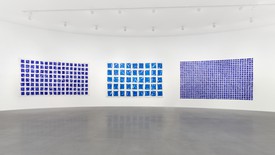galleryplatform.la
Ed Ruscha
Drum Skins
May 28–June 30, 2020
There’s a peculiar kind of patois, like Okie jargon. People have a funny way of speaking, almost like using bad English, double negatives like, “I can’t find my keys nowhere.” . . . Yes, they were incorrect, but they had a punch to them.
—Ed Ruscha
Gagosian is pleased to present recent paintings by Ed Ruscha online for galleryplatform.la. The works are currently featured in the solo exhibition Drum Skins at the Blanton Museum of Art at the University of Texas at Austin. The museum is currently closed due to the ongoing health crisis, but the show can be explored through a 360° virtual tour.
Fifty years ago, Ruscha purchased a set of vellum drum skins from a leather shop in Los Angeles. He has continued to collect these vintage objects, and since 2011 he has used them as canvases for the works on view at the Blanton Museum of Art. In these paintings, Ruscha wraps a slangy phrase—each one chock full of double and triple negatives—around the perimeter of a drum skin. The resulting compositions are fresh and evocative, while also harking back to the crisp, colorful text paintings about the idiosyncrasies of West Coast life for which Ruscha is known. Here, however, he looks back to his earlier hometown of Oklahoma City, evoking the Americana of his youth with fondness and wit. The drum skin paintings possess a warm nostalgia that transports the artist’s fine-tuned visual language back to a simpler time and place.
In 1980, Larry Gagosian opened his first gallery in Los Angeles. In the forty years since, the gallery has continued to celebrate the city’s vibrant arts scene. We are thrilled to be among the founding members of galleryplatform.la, and we look forward to broadening our contribution to Los Angeles’s artistic community through this new initiative.
#EdRuscha
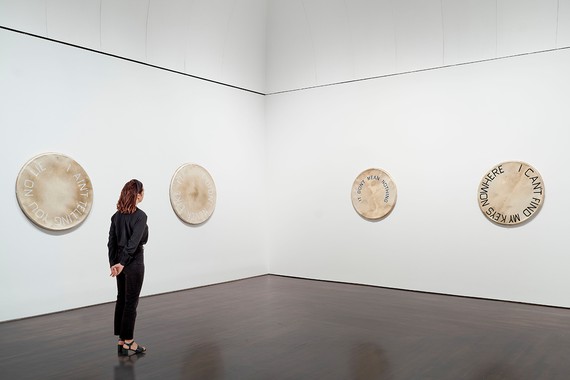
Installation view, Ed Ruscha: Drum Skins, Blanton Museum of Art, University of Texas at Austin, January 11–October 4, 2020. Artwork © Ed Ruscha
Related News
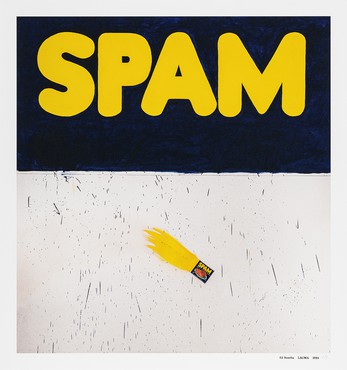
Support
Ed Ruscha × Avant Arte
Limited-Edition Print for LACMA
Ed Ruscha has partnered with Avant Arte, an online art marketplace, to create a limited-edition print of his painting Actual Size (1962) on the occasion of ED RUSCHA / NOW THEN, a major retrospective of his work at the Los Angeles County Museum of Art. A portion of proceeds from sales will benefit the museum’s future. The print will be available for purchase online at Avant Arte for forty-eight hours beginning at 1pm ET on Thursday, April 11, 2024. The edition size will be determined by the number of orders placed within the timed-release period. Each print is individually numbered and authenticated with a bespoke artist’s stamp.
Ed Ruscha, Actual Size, 2024 © Ed Ruscha

Honor
Ed Ruscha
California Hall of Fame
Ed Ruscha will be inducted into the California Hall of Fame for his service to the arts in a ceremony taking place on Tuesday, December 13, 2022, at which he will receive a medal from California Governor Gavin Newsom. Established in 2006 at the California Museum in Sacramento by former Governor Arnold Schwarzenegger and First Lady Maria Shriver, the award honors legendary Californians who embody the state’s innovative spirit and have made their mark on history across a variety of fields, including the arts, education, business and labor, science, sports, philanthropy, and public service.
Ed Ruscha in his studio, Los Angeles, 2008. Photo: Kate Simon
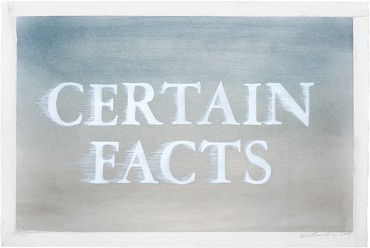
In Conversation
Adam McEwen, Bob Monk, and Lisa Turvey on Ed Ruscha
Tuesday, September 22, 2020, 5pm EDT
On the occasion of Artist Spotlight: Ed Ruscha, join artist Adam McEwen, Gagosian director Bob Monk, and Lisa Turvey, editor of the catalogue raisonné of Ed Ruscha’s works on paper, for an online conversation. The trio will discuss how Ruscha has experimented with the sound, appearance, and sense of language to imbue his works on paper with humor and pathos. To join, register at zoom.us.
Ed Ruscha, CERTAIN FACTS, 2020 © Ed Ruscha. Photo: Fredrik Nilsen
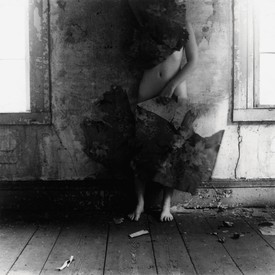
Francesca Woodman
Ahead of the first exhibition of Francesca Woodman’s photographs at Gagosian, director Putri Tan speaks with historian and curator Corey Keller about new insights into the artist’s work. The two unravel themes of the body, space, architecture, and ambiguity.
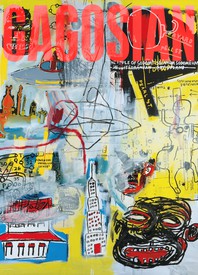
Now available
Gagosian Quarterly Spring 2024
The Spring 2024 issue of Gagosian Quarterly is now available with a fresh cover design featuring Jean-Michel Basquiat’s Lead Plate with Hole (1984).
Simon Hantaï: Azzurro
Join curator Anne Baldassari as she discusses the exhibition Simon Hantaï:Azzurro, Gagosian, Rome, and the significance of blue in the artist’s practice. The show forms part of a triptych with Gagosian’s two previous Hantaï exhibitions, LES NOIRS DU BLANC, LES BLANCS DU NOIR at Le Bourget in 2019–20, and Les blancs de la couleur, la couleur du blanc in New York, in 2022.
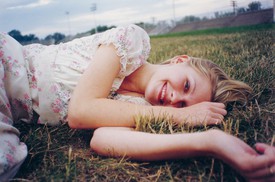
Sofia Coppola: Archive
MACK recently published Sofia Coppola: Archive 1999–2023, the first publication to chronicle Coppola’s entire body of work in cinema. Comprised of the filmmaker’s personal photographs, developmental materials, drafted and annotated scripts, collages, and unseen behind-the-scenes photography from all of her films, the monograph offers readers an intimate look into the process behind these films.
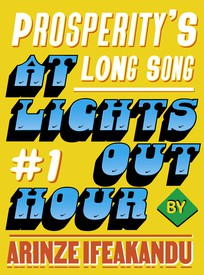
Prosperity’s Long Song #1: At Lights-Out Hour
We present the first installment of a four-part short story by Arinze Ifeakandu. Set at the Marian Boys’ Boarding School in Nigeria, “Prosperity’s Long Song” explores the country’s political upheavals through the lens of ancient mythologies and the mystical power of poetry.
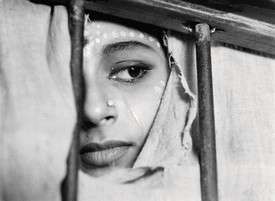
Mount Fuji in Satyajit Ray’s Woodblock Art, Part II
In the first installment of this two-part feature, published in our Winter 2023 edition, novelist and critic Amit Chaudhuri traced the global impacts of woodblock printing. Here, in the second installment, he focuses on the films of Satyajit Ray, demonstrating the enduring influence of the woodblock print on the formal composition of these works.
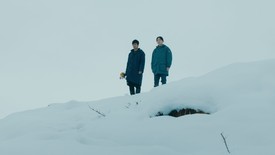
Adaptability
Adam Dalva looks at recent films born from short stories by the Japanese writer Haruki Murakami and asks, What makes a great adaptation? He considers how the beloved surrealist’s prose particularly lends itself to cinematic interpretation.
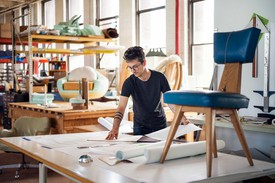
Vladimir Kagan’s First Collection: An Interview with Chris Eitel
Chris Eitel, Vladimir Kagan’s protégé and the current director of design and production at Vladimir Kagan Design Group, invited the Quarterly’s Wyatt Allgeier to the brand’s studio in New Jersey, where the two discussed the forthcoming release of the First Collection. The series, now available through holly hunt, reintroduces the first chair and table that Kagan ever designed—part of Eitel’s efforts to honor the furniture avant-gardist’s legacy while carrying the company into the future.
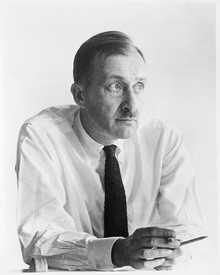
Game Changer: Alexey Brodovitch
Gerry Badger reflects on the persistent influence of the graphic designer and photographer Alexey Brodovitch, the subject of an upcoming exhibition at the Barnes Foundation, Philadelphia.
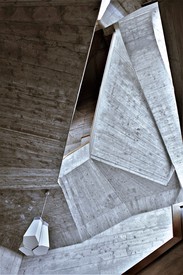
Goetheanum: Rudolf Steiner and Contemporary Art
Author and artist Ross Simonini reports on a recent trip to the world center of the anthroposophical movement, the Goetheanum in Switzerland, exploring the influence of the movement’s founder and building’s designer Rudolf Steiner on twentieth-century artists.
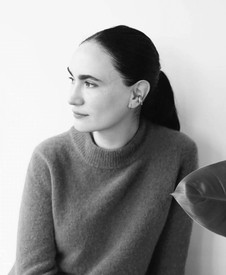
Hans Ulrich Obrist’s Questionnaire: Frida Escobedo
In this ongoing series, curator Hans Ulrich Obrist has devised a set of thirty-seven questions that invite artists, authors, musicians, and other visionaries to address key elements of their lives and creative practices. Respondents select from the larger questionnaire and reply in as many or as few words as they desire. For the first installment of 2024, we are honored to present the architect Frida Escobedo.
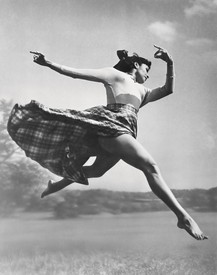
Border Crossings: Exile and American Modern Dance, 1900–1955
Dance scholars Mark Franko and Ninotchka Bennahum join the Quarterly’s Gillian Jakab in a conversation about the exhibition Border Crossings at the New York Public Library for the Performing Arts. Cocurated by Bennahum and Bruce Robertson, the show reexamines twentieth-century modern dance in the context of war, exile, and injustice. An accompanying catalogue, coedited by Bennahum and Rena Heinrich and published earlier this year, bridges the New York presentation with its West Coast counterpart at the Art, Design & Architecture Museum at the University of California, Santa Barbara.
